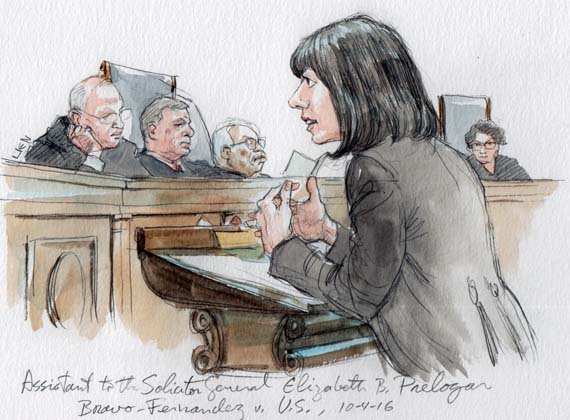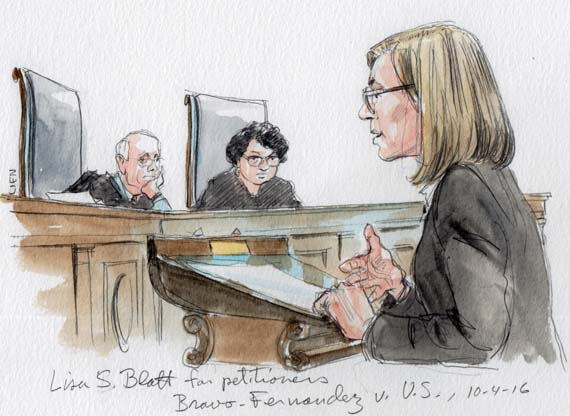Argument analysis: Can a vacated conviction deprive a jury acquittal of double jeopardy preclusive effect?

on Oct 5, 2016 at 9:36 am
As I noted in my preview of Bravo-Fernandez v. United States, a complex double jeopardy case, sometimes oral argument can cast a case as more one-sided than it seemed going in. The transcript of Tuesday’s argument suggests that the court may be leaning in the government’s favor here.
The jury returned both acquittals and a conviction: What does that mean?
Recall that businessman Juan Bravo-Fernandez and a senator for the commonwealth of Puerto Rico were tried together on three federal-program-bribery counts in 2005. The jury returned verdicts of not guilty on two counts (traveling interstate to commit the bribery and conspiracy to commit the bribery), but convicted on the substantive bribery count. Even in the face of seeming inconsistency, such a conviction would normally be upheld – but here the conviction count was reversed on appeal because the jury was misinstructed on the definition of bribery.
The defendants then argued that, since travel and conspiracy were not factually contested, the only reason the jury could have acquitted them on those counts was by deciding they had not committed bribery. Therefore, they maintained, the government should not be able to retry them on the bribery count, because that issue had already been “necessarily decided” against the government in the first trial.
According to the government, however, the jury’s conviction shows that the jury unanimously agreed that the defendants did commit bribery – or at the very least, that the jury was confused so we can’t know what they really thought. For that reason, the government argued that it should be allowed to try Bravo-Fernandez and his codefendant on the vacated bribery count with the erroneous jury instructions corrected. As Assistant to the Solicitor General Elizabeth Prelogar contended Tuesday morning, there’s a “strong societal interest in ensuring that the government has a [full] opportunity to enforce the criminal laws.”

Elizabeth B. Prelogar, Assistant to the Solicitor General (Art Lien)
Precedents point in different directions, and the issue is undoubtedly unsettled
The defendants’ argument rests on two cases. Almost half a century ago in Ashe v. Swenson, the Supreme Court ruled that when the record shows that a jury’s acquittal “necessarily decided” an essential element of an offense adversely to the government, a defendant can’t be tried on another count that requires proof of that same element. Ashe involved a single “clean” acquittal that, the court ruled, “collaterally estopped” the government from trying Bob Fred Ashe in a new trial on related counts. In short, Ashe held that the government gets one chance to prove the disputed element, not two.
Thirty-nine years after Ashe, the court was confronted with a different procedural context. In Yeager v. United States, the jury acquitted the defendant in a single trial on some counts, but it “hung” (that is, it did not reach a unanimous verdict) on other counts. The court ruled in Yeager that such a non-decision by the jury cannot be relied on to tell us anything; just as in Ashe, all we can know is that by acquitting, the jury “necessarily decided” essential elements against the government. So another trial on the hung counts is precluded by the Fifth Amendment’s double jeopardy clause.
Bravo-Fernandez and his co-defendant now argue that Ashe and Yeager control the outcome of this case, and that an invalid conviction should not be considered to prove anything, any more than a hung jury’s verdict can.
However, between its decisions in Ashe and Yeager, the court ruled in United States v. Powell that if a jury returns mixed verdicts in the same trial – that is, convictions on some counts and acquittals on others – the convictions stand, even if they are logically inconsistent. This rule is grounded in respect for the jury’s role, and in the understanding that we cannot really know why a jury renders mixed verdicts: It might be due to logical inconsistency or it might stem from confusion or pure sympathy. The government now argues that Powell shows that what the jury “necessarily decides” when it both acquits and convicts simply can’t be determined; because the defendant bears the burden of showing what was “necessarily decided” in order to gain the collateral estoppel protection of Ashe, Powell means that burden can’t be carried when a conviction is returned with acquittals – even a conviction later reversed on appeal. Thus, the government contends, Bravo-Fernandez and his codefendant can be retried on the bribery count, under the normal rule that allows vacated convictions to be retried.
Tuesday’s oral arguments seemed to favor retrial
With Justice Antonin Scalia absent, Justice Anthony Kennedy asked the first question of the 2016 Term (still, as usual, just a few sentences into Lisa Blatt’s presentation for the defendants). He pointed out that there can be cases where acquittals cannot tell us what the jury “necessarily decided.” Blatt responded, however, that in this case the government has never disputed that the verdicts were inconsistent as to whether bribery was proved.

Lisa S. Blatt for petitioners (Art Lien)
But then Justice Ruth Bader Ginsburg – for whom Blatt had clerked on the U.S. Court of Appeals for the D.C. Circuit – interjected, making a somewhat surprising point which she repeated twice more before the hour was up. “This jury, we don’t know what it decided, because of the inconsistency… It might just have decided that conviction of … bribery was enough, and that the government had laid it on too strong by adding the” other two counts. That is, as Ginsburg again explained during Blatt’s rebuttal, “the jury might have reacted to the overcharging by [convicting for bribery but then] … saying we’re not going to convict on these compound offenses.” In other words, as Ginsburg later put it, “if we’re trying to find out what this jury found … how do we know that’s not what the jury decided?”: It may have decided to compromise, not that no bribery was committed.
Thus Ginsburg quickly used a point that the defendants and several “friends of the court” had strongly pushed in their briefs – the dangers of overcharging where the proliferation of criminal statutes allows prosecutors to charge many counts from a single crime – against Bravo-Fernandez’s position. If Ashe requires a defendant to show what a jury’s acquittal “necessarily decided,” Ginsburg suggested, doesn’t the jury’s unanimous decision to convict on one count preclude that showing, because they might have decided to acquit on the other counts out of sympathy or anger, rather than necessarily deciding against bribery?
Blatt gamely pointed out that the court has “never, ever, ever” allowed the use of a vacated conviction to prove anything. But, Justice Elena Kagan repeatedly inquired: “Why do we do that? … What part of the Constitution tells us that?” Meanwhile, as Kagan, Kennedy, and Justice Samuel Alito all asked, isn’t even a vacated conviction “part of the factual picture,” that is, a “historical fact” that can be considered in decided what the jury’s mixed verdicts might mean? When Blatt responded that a jury verdict “doesn’t count in our legal system unless it’s … final[],” Justice Sonia Sotomayor also asked, and not supportively, “why is that true?”
Indeed, Chief Justice John Roberts may have quietly settled the case when he noted that “you [the defendant] have the burden … of carrying … a double jeopardy violation.” (When Roberts later said “I guess everybody agrees it’s the defendant’s burden,” no justice suggested otherwise.) When that burden is combined with Ginsburg’s point that the jury here may have exercised leniency by acquitting, rather than “necessarily” deciding there was no bribery, the chief justice’s remarks might prove dispositive: “[I[f you don’t know [what the jury necessarily decided], then you can’t carry that burden.”
Blatt steadily stuck to her arguments that Yeager controls and that history supports the view that invalid convictions do not “count” for anything. However, if there is truth to the view that the party asked the most questions at a Supreme Court oral argument will lose, then the defendants are at a disadvantage here. Not only did Prelogar get long periods of uninterrupted argument for the government, but Ginsburg, who is generally viewed as somewhat defense-friendly, also noted that “it’s not [even] clear that the [jury] charge was erroneous, is it?” This suggested that perhaps the jury’s conviction should not have been vacated at all. (That question, however, was not presented by any cross-petition from the government.) Meanwhile, Ginsburg also noted that there was, in this particular case, “much evidence” to support the bribery conviction. The court also noted that if the instructional definition of bribery was wrong, then it was wrong for all three counts, again making the jury’s verdicts “indecipherable” rather than proof of what was “necessarily decided.”
When the time came for Prelogar (also a former clerk to Justice Ginsburg) to argue for the government in the second half hour, a few justices did ask her some hard questions. But on her central point – that the jury’s mixed verdicts make it impossible to determine what was “necessarily decided” – she was not challenged and spoke for several minutes at a time without interruption.
Conclusion
In the end, this case seems to tug at both the heart and the head, but in opposite directions. As Kagan noted early on, “there’s something very powerful, rhetorically, in” the fact that vacated convictions have never historically been allowed to prove anything. Kagan observed that the defendants “have the history on [their] side,” and she pointed out to the government that “there’s something ‘unseemly’” about using a vacated conviction to a defendant’s disadvantage. At the same time, Blatt also stressed that jury acquittals are “sacrosanct” in our justice system, and “acquittal has to mean something under Ashe.”
The government, however, noted that the defendants enjoy the full benefit of the acquittals – they cannot be retried on those two counts. The only question is whether they should receive a further, “collateral,” protection from retrial on the third, vacated count under Ashe. Meanwhile, in the government’s view, the normal rule that vacated conviction counts can be retried serves “weighty interests.”
Lisa Blatt has a strong record of winning cases that she argues at the court. But on Tuesday, she was reduced to offering fruit metaphors: “apples and oranges,” “apples and apples,” and to describe this case, a “rotten infected apple with a worm.” Although an opinion deciding this case won’t be issued for weeks, and I always counsel against drawing firm conclusions from an argument or transcript alone, the justices did not appear to be buying, or eating, the defense position here.
[Disclosure: Vinson & Elkins LLP, whose attorneys contribute to this blog in various capacities, is among the counsel on an amicus brief in support of the petitioners in this case. The author of this post, however, is not affiliated with the firm.]


